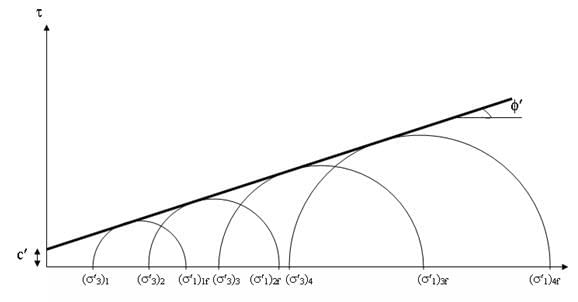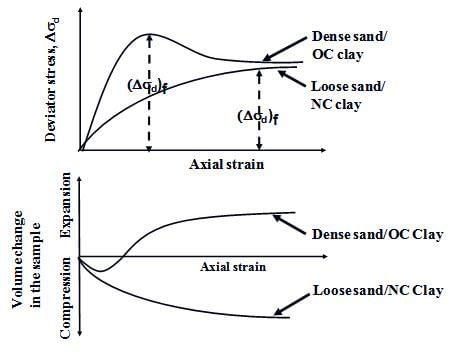Types of Triaxial Tests - Strength Parameters of Soil, Soil Mechanics | Soil Mechanics Notes- Agricultural Engineering PDF Download
Various Types of Tri-axial Tests
In triaxial test, tests are conducted in two stages, Stage I: under all round cell pressure (s3) and Stage II: under shearing or loading (as shown in Figure 12.1). During all round cell pressure, if drainage is allowed the consolidation takes place in the sample. This type of sample is called consolidated sample. However, if drainage is not allowed then the sample is called unconsolidated sample. During shearing or loading (Deviatoric stress, Δσd = σ1 - σ3), if drainage is allowed the loading is called drained loading. However, if drainage is not allowed then the loading is called undrained loading. Figure 12.2 shows a triaxial test setup. The drainage in the sample is controlled by closing or opening the drainage valve. The all round cell pressure is applied by using water inside the triaxial cell.

Fig. 12.1. Stages of Tri-axial tests.

Fig. 12.2. Tri-axial tests test setup
The usual sizes of the samples are: 76 mm (length) x 38 mm (diameter) or 100 mm (length) x 50 mm (diameter). Thus, the length/diameter ratio of the cylindrical sample is 2. This test is suitable for both sand and clay. Depending on whether drainage is allowed or not during all round cell pressure and shearing, three types of triaxial tests are conducted:
(i) Unconsolidated Undrained (UU) test
(ii) Consolidated Undrained (CU) test
(iii) Consolidated Drained (CD) test
Unconsolidated Undrained (UU) test
In this type of test, pore pressure is developed during shearing. However, the pore water pressure is not measured. Thus, effective stress value is unknown. The parameters are determined in terms of total stress (cu). It is a very quick test. The determined parameters are used for the analysis under undrained condition such as short term stability.
Consolidated Undrained (CU) test
In this type of test, pore pressure is developed during shearing and it is also measured. Thus, effective stress value is known. The parameters are determined in terms of effective stress (c' and Ø' ). It is faster than CD test, but slower than the UU tests. This test is preferred to determine c' and Ø'.
Consolidated Drained (CD) test
In this type of test, no excess pore pressure is developed during the whole test. Shearing is done very slowly to avoid build-up the excess pore water pressure. The parameters are determined in terms of effective stress (c' and Ø'). It is a very slow test (can take few days). The determined parameters are used for the analysis under fully drained condition such as long term stability.
In general, during the test, deviator stress (σ1 - σ3), all round pressure (σ3) and pore water pressure is measured (for example in CU test). From the test data, (σ1)f value at failure is determined for different cell pressure (σ3). After subtracting the pore water pressure, (σ1)'f and σ'3 are determined. Mohr-Circles are drawn for different (σ1)'f and σ'3 values. Failure envelop is drawn by drawing a common tangential line for all the circles (as shown in Figure 12.3). From that line, strength parameters c' and Ø are determined. Figure 12.4 shows typical deviator stress-axial strain and volume change-axial strain plot of soils obtained from CD trai-axial tests.

Fig. 12.3. Shear stress-normal stress plot.

Fig.12.4. Deviator stress-axial strain and volume change-axial strain plot of
soils obtained from CD t Tri-axial tests.
FAQs on Types of Triaxial Tests - Strength Parameters of Soil, Soil Mechanics - Soil Mechanics Notes- Agricultural Engineering
| 1. What are the different types of triaxial tests used to determine the strength parameters of soil in soil mechanics? |  |
| 2. What is the purpose of conducting triaxial tests in soil mechanics and agricultural engineering? |  |
| 3. How are the strength parameters of soil determined from triaxial tests? |  |
| 4. What are the applications of triaxial tests in agricultural engineering? |  |
| 5. What are the limitations of triaxial tests in determining the strength parameters of soil? |  |















